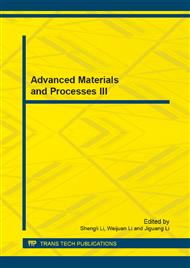p.371
p.377
p.380
p.385
p.389
p.399
p.403
p.407
p.411
Studies on In Vitro Release Performance of Hydrophilic Drugs and Lipophilic Drugs in Amphiphilic SIS-Based Hot-Melt Pressure Sensitive Adhesives
Abstract:
In order to fabricate a kind of amphiphilic hot-melt pressure sensitive adhesives (HMPSAs) suitable for transdermal drug delivery systems (TDDS) of natural medicines, SIS-based hot-melt pressure sensitive adhesives were modified by a melt-blending method, in which a kind of hydrophilic poly (ethyl acrylate-co-methyl methacrylate-co-trimethylammonioethyl methacrylate chloride) (RLPO) and polyethylene glycol 2000 (PEG2000) were utilized. Functional RLPO and its plasticizer PEG2000 worked as a hydrophilic skeleton of amphiphilic HMPSAs. SEM and FT-IR results indicated that RLPO and SIS were partially compatible with each other through n-π complex between the n electrons of the carbonyl group of RLPO and the π electrons of the benzene rings of SIS and their compound had a good thermal stability. The phase microscope images showed that PEG could improve the compatibility between RLPO phase and SIS phase. As the ratio of SIS/RLPO/PEG equaled to 1/2/1.6, their compounds obtained bi-continuous structures. Geniposide (logP<0) and oleanic acid (logP=9.0) were chosen as representatives of hydrophilic drugs and lipophilic drugs, respectively. It was observed that both hydrophilic drugs and lipophilic drugs had a continuous release in the optimized amphiphilic HMPSAs. In addition, the release behavior of hydrophilic geniposide could be controlled by adjusting the ratio of RLPO to PEG.
Info:
Periodical:
Pages:
389-398
Citation:
Online since:
September 2013
Authors:
Keywords:
Price:
Сopyright:
© 2013 Trans Tech Publications Ltd. All Rights Reserved
Share:
Citation:


